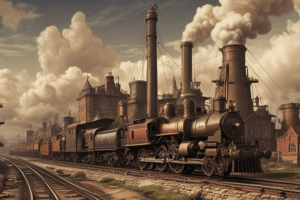Podcast
Questions and Answers
What was a key feature of the factory system introduced by Richard Arkwright in 1790?
What was a key feature of the factory system introduced by Richard Arkwright in 1790?
- Division of labor and specialization of tasks (correct)
- A return to cottage industry and domestic system
- Improved working conditions for workers
- Increased autonomy for workers
What was a result of the introduction of the factory system on workers?
What was a result of the introduction of the factory system on workers?
- They moved from rural areas to urban centers (correct)
- They had more independence and traditional skills
- They experienced better working conditions and higher wages
- They worked shorter hours
What was a benefit of the factory system?
What was a benefit of the factory system?
- A return to traditional skills
- Increased independence for workers
- Lower production costs and increased output (correct)
- Improved working conditions
What proportion of factory workers were made up of women and children?
What proportion of factory workers were made up of women and children?
What was a challenge faced by women in the industrial workforce?
What was a challenge faced by women in the industrial workforce?
What was an impact of the Industrial Revolution on women's lives?
What was an impact of the Industrial Revolution on women's lives?
What was a result of women moving from domestic work to factory work?
What was a result of women moving from domestic work to factory work?
What did women often perform in the industrial workforce?
What did women often perform in the industrial workforce?
Flashcards are hidden until you start studying
Study Notes
Factory Systems
- Key features:
- Introduced by Richard Arkwright in 1790
- Replaced cottage industry and domestic system
- Workers employed in a single location, under one roof
- Division of labor and specialization of tasks
- Use of machinery and power-driven equipment
- Increased efficiency and productivity
- Impact on workers:
- Workers moved from rural areas to urban centers
- Long working hours, low wages, and poor working conditions
- Loss of independence and traditional skills
- Creation of a new industrial working class
- Benefits:
- Increased productivity and efficiency
- Lower production costs
- Increased output and economic growth
Women in the Industrial Revolution
- Role in the workforce:
- Women and children made up a significant proportion of factory workers
- Employed in textile and textile-related industries
- Worked long hours for low wages, in poor conditions
- Often performed unskilled or semi-skilled tasks
- Impact on women's lives:
- Moved from domestic work to factory work
- Increased independence and autonomy
- Exposure to new social and economic networks
- Changes in traditional gender roles and expectations
- Challenges faced:
- Sexual harassment and exploitation
- Poor working conditions and health risks
- Limited access to education and training
- Struggles for better wages and working conditions
Studying That Suits You
Use AI to generate personalized quizzes and flashcards to suit your learning preferences.




